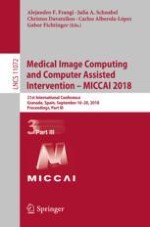2018 | OriginalPaper | Buchkapitel
Spatially Localized Atlas Network Tiles Enables 3D Whole Brain Segmentation from Limited Data
verfasst von : Yuankai Huo, Zhoubing Xu, Katherine Aboud, Prasanna Parvathaneni, Shunxing Bao, Camilo Bermudez, Susan M. Resnick, Laurie E. Cutting, Bennett A. Landman
Erschienen in: Medical Image Computing and Computer Assisted Intervention – MICCAI 2018
Aktivieren Sie unsere intelligente Suche, um passende Fachinhalte oder Patente zu finden.
Wählen Sie Textabschnitte aus um mit Künstlicher Intelligenz passenden Patente zu finden. powered by
Markieren Sie Textabschnitte, um KI-gestützt weitere passende Inhalte zu finden. powered by
